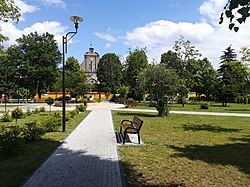Widawa, Łódź Voivodeship
Widawa | |
|---|---|
Village | |
 Market square with the church of the Exaltation of the Holy Cross in the background | |
| Coordinates: 51°26′14″N 18°56′21″E / 51.43722°N 18.93917°E | |
| Country | |
| Voivodeship | Łódź |
| County | Łask |
| Gmina | Widawa |
| Population | |
• Total | 1,300 |
| Time zone | UTC+1 (CET) |
| • Summer (DST) | UTC+2 (CEST) |
| Vehicle registration | ELA |
Widawa [viˈdava] is a village in Łask County, Łódź Voivodeship, in central Poland.[1] It is the seat of the gmina (administrative district) called Gmina Widawa. It lies approximately 22 kilometres (14 mi) south-west of Łask and 53 km (33 mi) south-west of the regional capital Łódź. It is located in the Sieradz Land.
History
[edit]
Widawa was founded in the Middle Ages. In 1388 King Władysław II Jagiełło vested Widawa with town rights. It was a private town, administratively located in the Sieradz County in the Sieradz Voivodeship in the Greater Poland Province of the Kingdom of Poland.[2] In 1638 the local Wężyk Widawski noble family founded a Bernardine monastery.[3] During the Deluge (Swedish invasion of Poland), a battle between Poland and Sweden was fought nearby in 1656, and the town was devastated.[3] The Walewski family rebuilt the monastery in the following decades and erected the Baroque church of the Exaltation of the Holy Cross, which remains the greatest historic landmark of Widawa.[3] Nowadays, a museum is located in the monastery.[3] In the 18th century, one of two main routes connecting Warsaw and Dresden ran through the town and Kings Augustus II the Strong and Augustus III of Poland often traveled that route.[4]
Before World War II, the town included about 800 Jews, around one-third of the town's population. On arrival in September 1939, the Germans burned the community's rabbi Abraham Mordechaij Maroko alive because he would not burn the Torah scrolls. During the next two years, the Germans sent many of the town's Jews to forced labour camps and forced others to live in a concentrated ghetto. Some Jews were also sent to Bełchatów. Eventually, most of Widawa's Jews were sent to the Chełmno extermination camp where they were immediately gassed. Few survived the war.[5]
References
[edit]- ^ "Central Statistical Office (GUS) - TERYT (National Register of Territorial Land Apportionment Journal)" (in Polish). 2008-06-01.
- ^ Atlas historyczny Polski. Województwo sieradzkie i województwo łęczyckie w drugiej połowie XVI wieku. Część I. Mapy, plany (in Polish). Warszawa: Instytut Historii Polskiej Akademii Nauk. 1998. p. 4.
- ^ a b c d "Kościół i dawny klasztor oo. bernardynów, Widawa". Zabytek.pl (in Polish). Retrieved 11 December 2020.
- ^ "Informacja historyczna". Dresden-Warsaw (in Polish). Retrieved 11 December 2020.
- ^ Megargee, Geoffrey (2012). Encyclopedia of Camps and Ghettos. Vol. 2. Bloomington, Indiana: University of Indiana Press. pp. 113–114. ISBN 978-0-253-35599-7.


